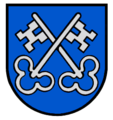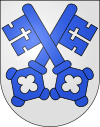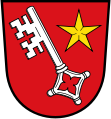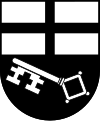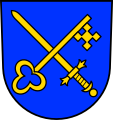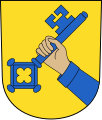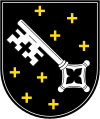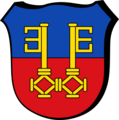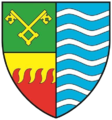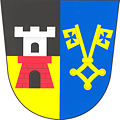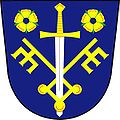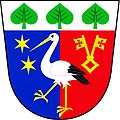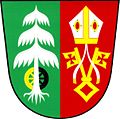Key (heraldry)
The key in the heraldic shield as a common heraldic figure is a sign of open-mindedness. He is also a symbol for Peter . The veneration of saints brought him into the coat of arms. Sometimes a coat of arms key is interpreted as locked .
Many display options and other special features are not to be expected here. As a single piece in the shield, the key can assume all positions of a common figure. The location is pile , beam or sloping . It can be shown floating on its own (normal case) or in the case of a human figure or a heraldic animal as holding in the hands / fangs , as well as diverse as other accessories. In the normal position, the rider (ring) points upwards (naturally hanging), the reverse position is emblazoned ( fallen key) . Because the keys usually symbolically unlock a gate, the fallen situation is by far the most widespread (and is therefore sometimes not explicitly stated if the reference to Peter is clear). The normal position of the beard is on the stalk (the “stem”) pointing to the right (left of the viewer), any different position is also reported. When used in the upper coat of arms , the pommel is depicted on a figure or the key to the independent figure, on the crown or helmet.
In general, no details are given, all decorations are left to the heraldist, but the most common representation is the classic tumble key . The beard is usually represented by a very simple shape, less often than a double beard , it can also be shaped in a very complicated manner and have various recesses, for example in the form of a cross or a lily, as was also common with historical keys (hence the name "Mustache"). The rings are often shaped as a Gothic quatrefoil .
In coats of arms crossed or intertwined in the rings , as well as keys placed against each other are used. The latter can also be on the other person's beard with the ring. The key or keys are often crossed behind the coat of arms. Keys and scepter , crozier , etc. are held together with tape or cord cords. A special feature is the double key: Here a key with two opposite beards, often divided just above the rider, or on a key shaft with two beards is shown.
Metals are preferred in the choice of color, i.e. gold (yellow) or silver (white).
The image is popular in church heraldry . The keys of Peter , i.e. the crossed keys in particular in the papal and Vatican coats of arms , are a symbol of the Pope's power as the representative of Jesus Christ on earth. These crossed keys are called tie and release keys .
Examples
- crossed keys
Pope's coat of arms of Benedict XVI. with tie and release key
Regensburg coat of arms
Waldau coat of arms
Coat of arms from Wangen an der Aare
in the Schruns coat of arms
- Single key
Key with upturned beard. Bremen coat of arms
Vertical key in the coat of arms of Weilheim an der Teck with four-pass width
Coat of arms of the city of Worms
Coat of arms of the city of Brilon
Key in the coat of arms of Stetten (Bodenseekreis)
Peter with key in the city arms of Trier
and in Peterzell
Wallisellen coat of arms
Coat of arms of the diocese of Worms
Two individual keys in the coat of arms of Bernkastel-Kues
- Double key
and the incorporated Uerdingen
Double key from Nidwalden
Double key from Allershausen
Double key from Untersiebenbrunn
Double key in Moosbrunn
Double key in Hernstein
Double key in Dvorce u Jihlavy
Double key in Kozlov (Jihlava District)
Double key in Kirchdorf an der Amper



